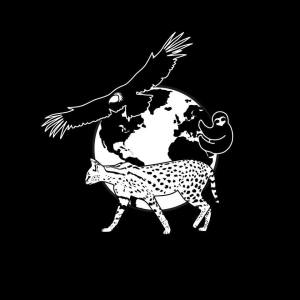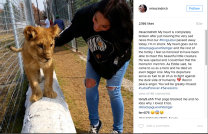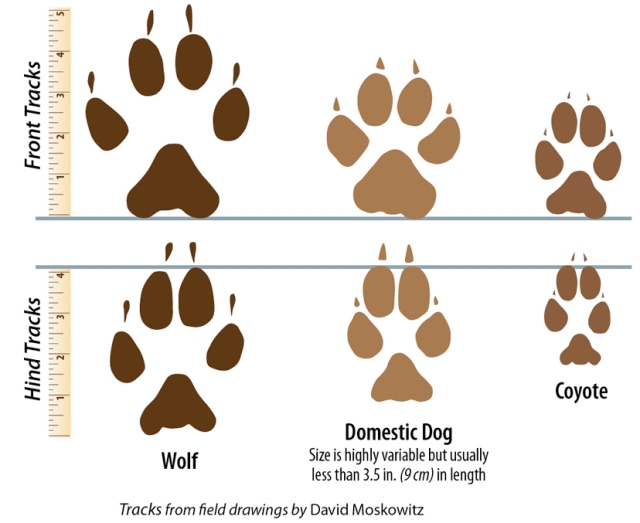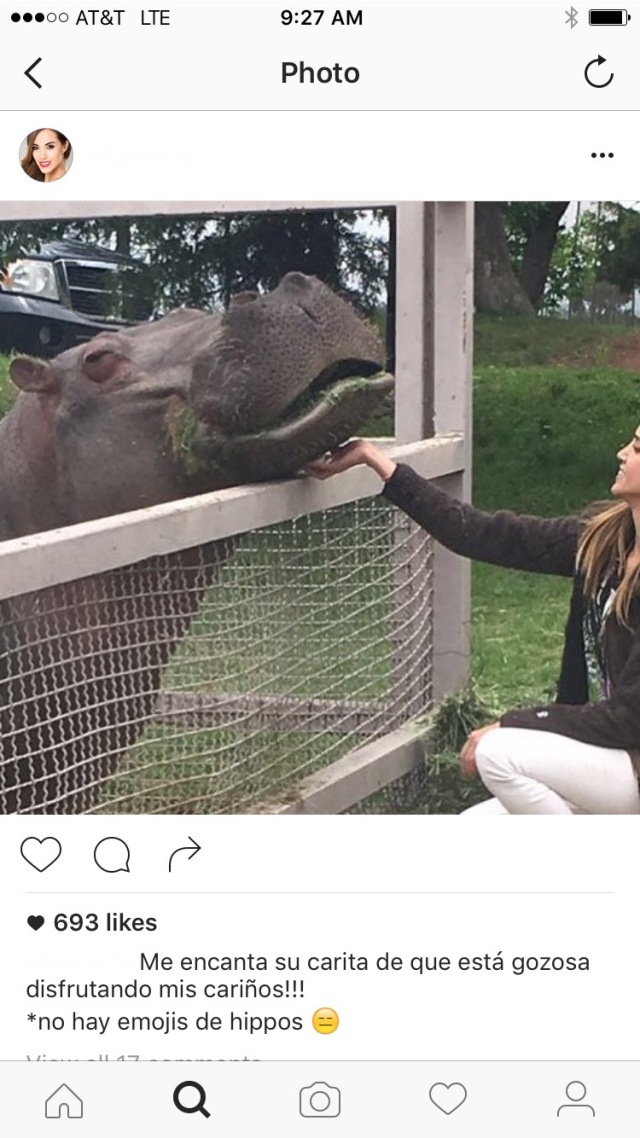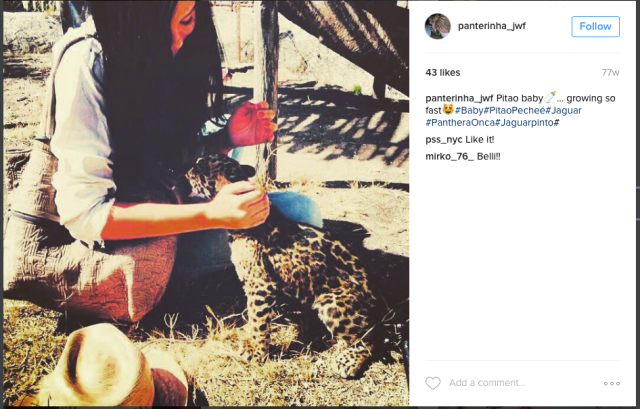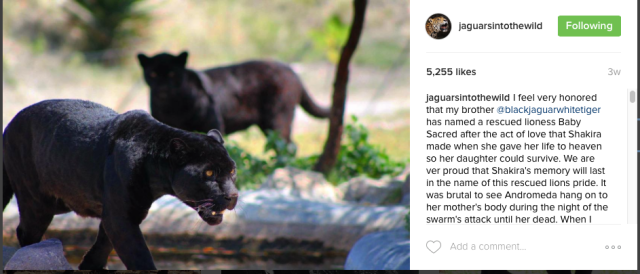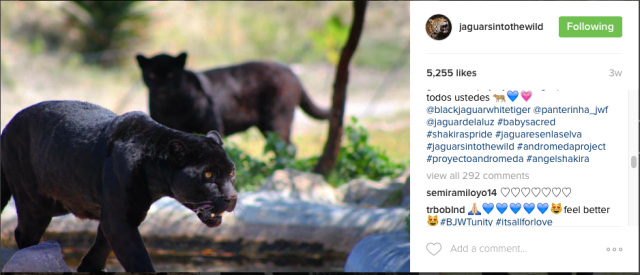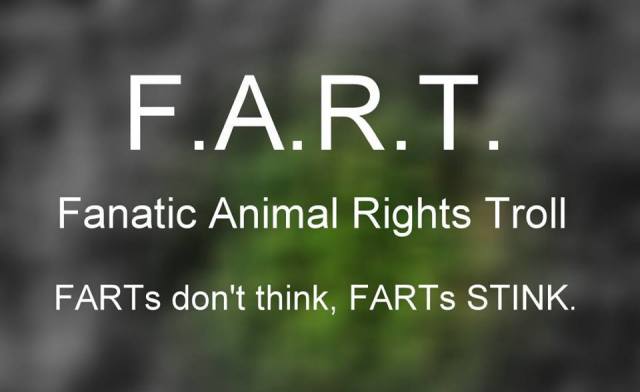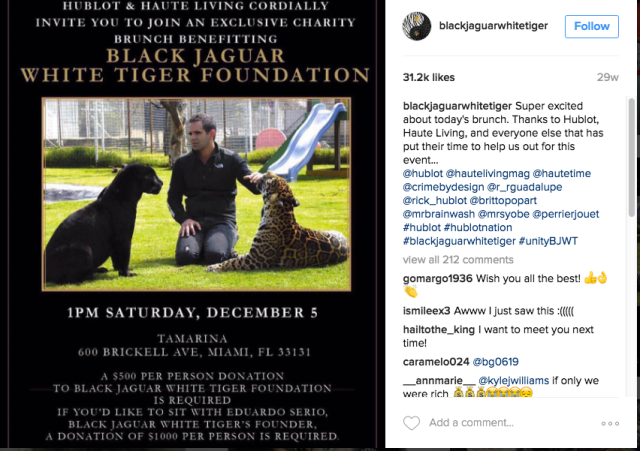*This article would have been published in the next few weeks. However, it is being published ahead of schedule and without being entirely complete due to the recent, savage, and completely FALSE public accusations made by Eduardo Serio of Black Jaguar White Tiger against a heroic young woman who sought to help us and others take a stand against Serio, his lies and his abuse.
Somewhere in Colombia, six lions live in dilapidated circus carriages, the bars eaten with rust, the floors partially rotting. Four lionesses exist cramped together in one, two males in the other. They languish, the distasteful reminder of a country that tried to take a step forward in conservation by banning animal acts in circuses, but failed to consider the lives of the animals they were supposedly protecting. When Colombia made it illegal to utilize animal acts in circuses, it did so without having any feasible way to care for the hundreds of animals suddenly made homeless by their own policies. There was, and remains, scant documentation on the precise number of animals owned by circuses before the ban, or the number of animals abandoned since the ban was set in place. And with the responsibility of these animals strung between environmental agencies, such as the CRA (Corporación Autónoma Regional del Atlántico) things are anything but simple.
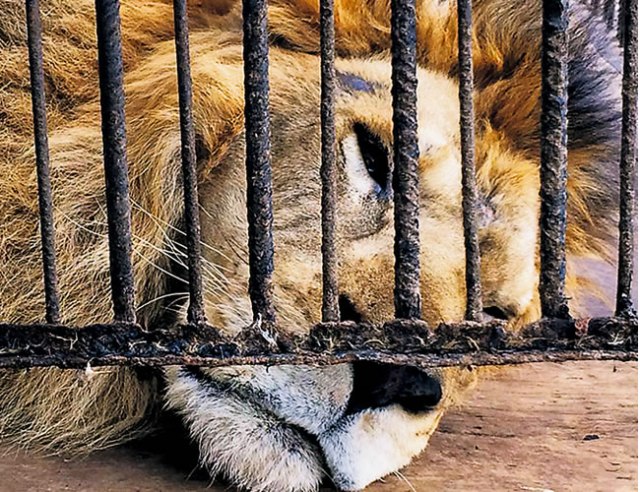
Though the six lions are only nine years old–young for lions–at least one of the original seven animals has died during their three years of abandonment. All that keeps starvation at bay for the remaining six, is the devoted attention of a few people, who see to it that the lions have food and water. None of the six animals have left their cramped cages in almost four years. They have not touched grass in even longer. Their suffering is a result of Colombia’s simple inability to provide sanctuary for captive exotic animals within their borders.
Though the country of Colombia has indicated it’s desire to join in the growing worldwide conservation movement, the country’s actions continue to show a stark failure to grasp the ethics required to join in such an endeavor. Quick “easy fixes” implemented by Colombia have only resulted in more suffering for the animals, as they were abandoned by owners who could no longer use them. There are no records of how many such animals died, either of starvation, or because their owners chose to kill them in order to comply with the new laws.
In the cases of abandonment, such as with these six lions, forsaken animals linger throughout the country, their fates irrevocably snared in a tangle of dysfunctional Colombian bureaucracy. Despite that Colombia supposedly wants to participate in conservation on an international level, no discernible effort has been made by the the government to secure placement for the hundreds of animals orphaned by their policies. Colombia isn’t the only country in this position, either. As many other countries begin to crackdown on animal exploitation, the matter of where those animals are supposed to live out the rest of their lives has become the foremost obstacle in freeing captive exotic animals from abuse and exploitation. Even when established and knowledgeable conservation groups offer help in addressing the issue, governments often fail to properly utilize that offer of aid. This situation in Colombia is a prime example of that failure.
The plight of the six lions discussed in this article, was brought into the international, and public arena, not by the CRA, but by one of the most well known animal exploiters in the world: Eduardo Serio, the founder of Black Jaguar White Tiger Foundation.
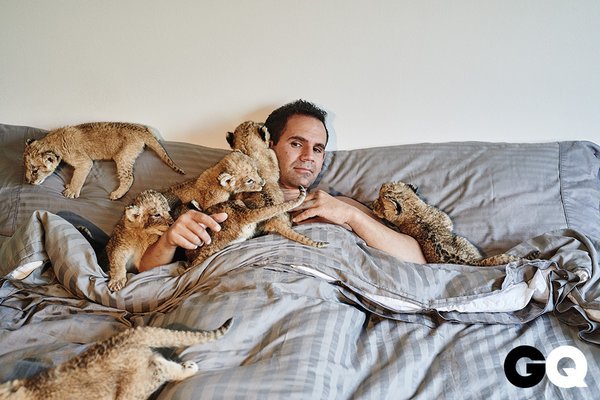
Famous for his videos and social media posts showcasing tigers running around his mansion, and lions playing in his backyard Eduardo Serio has owned big cats–as pets–since 2013.

Celebrity guests (many of them holdovers from Serio’s childhood days spent in Hollywood, attending parties for the elite) regularly visit Black Jaguar White Tiger, touting the facility while posing for photographs with Serio’s latest batch of big cat cubs, many of which have been purportedly obtained from breeders with whom Serio has connections.

Pictured: Kate Walsh Ref: SPL996172 140415
Picture by: EBLV / Splash News
Splash News and Pictures
Los Angeles: 310-821-2666
New York: 212-619-2666
London: 870-934-2666
photodesk@splashnews.com
If you ask Serio, he’s “rescued” over 200 big cats, in just three years. Some ignorant fans, like Eli Roth claim that BJWT has saved as many as 300 big cats, and repeat lies such as Serio quit his job in order to start the Foundation. Another popular lie that adoring fans are tricked into spreading is the idea that BJWT releases animals into some mystical “protected wild jungle” in Mexico. BJWT has never released a big cat into the wild. Most of their cats are hand raised from birth, and trained to interact with humans–such as guests like Roth, who then leave gushing about how wonderful BJWT is on their own social media hubs–and thus BJWT’s animals can never be released. As for how many animals Serio has “rescued”, according the the public records of the Mexican government, Serio has registered possession of only about 30 cats. The truth about how many cats BJWT possess remains elusive, in no small part, because the Mexican government has never inspected Black Jaguar White Tiger’s facilities. You read that correctly. Despite that SEMARNAT and Profepa actually send confiscated animals to Black Jaguar White Tiger, as of January of this year the public documents revealed no government evaluation, or inspection Eduardo Serio’s facility.
This lack of oversight has allowed Serio to literally make up his own rules and standards as he goes. The stories of even the most popular and well documented animals at Black Jaguar White Tiger change on a regular basis. Some cats, like Cielo, the first cat, a black Jaguar Eduardo obtained as a pet in 2013, have been declawed. Others, like Karma, the lion cub Eduardo obtained shortly after Cielo, have died. Some of these deaths remain unexplained to this day, while others have been reported by Serio in contradicting ways, as he changes their stories to suit himself and the situation. The deaths continue even now. In the last months, a healthy Margay died inexplicably. Serio blames many deaths on “inbreeding” but the majority of them–even without necropsy–can be irrefutably linked to mismanagement and improper care.
Karma died after chewing apart household furniture, the pieces of which perforated her intestines. Her last days and hours were filled with agony, while Serio farted around posting on social media that she was “getting better” and “almost perfect”.
Today, Serio adamantly denies that anyone found any wood or other foreign body inside of Karma. He maintains that she died on the operating table and that her death is a mystery. He claims that his “haters” have contrived the lie about Karma ingesting wood out of envy of Serio and his “kids”. He says that we spread this lie in order to “hurt” him. Apparently, he’s forgotten all of his own social media updates made while Karma was actively dying.
Likewise, a lion named Labai, suffered intestinal blockages from chewing on toys and furniture, while Serio posted on Instagram that he was “getting better”. In cases such as Labai’s, Serio patently blames the animals’ former owners, whoever they might be, even when the animals have been in BJWT’s care for weeks or months before problems arise.
Notice the age difference an appreciable growth between when Labai was rescued, and the photo of the young BJWT visitor with him before his death. Yet Serio asserts that his death was a direct result of the lion’s former owners.
In the early days of BJWT, Serio delighted in posting photos of shoes, flip flops, bedding and furniture which had been chewed apart by the cats in his care. He also posted photos of them playing with dog toys and other other inappropriate objects. Now, though, he denies ever allowing such things to take place, yet his cats continue to suffer from intestinal blockages, and digestive issues.
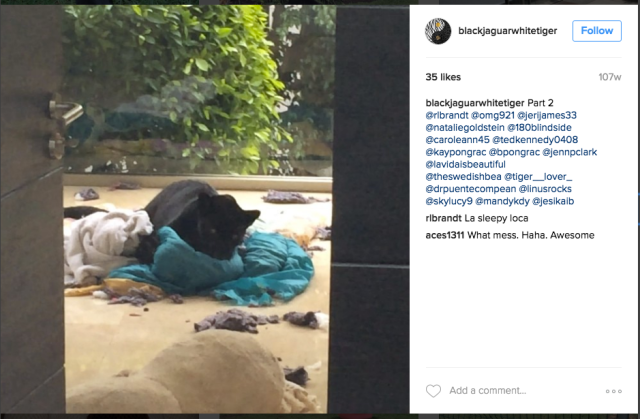
In recent times, the tiger cub, Arizona, regurgitated milk through her nose, due to being improperly fed during a live feed on Facebook (which was quickly deleted, but not before it was captured by several viewers) The tiger cub, just a couple of weeks old at the time, subsequently developed pneumonia and nearly died. Serio promptly blamed “inbreeding” for her trouble, despite that thousands of followers had watched her choke on milk until it drained out of her nose.
Dozens of animals have died in the three short years that Eduardo Serio has owned cats, many of them overlooked or completely forgotten by his devoted followers. There has even been speculation from our contacts within Mexico, that Serio intentionally makes his cats sick, so that he can then “save” them on social media, much to the acclaim of his devoted (and ignorant) fans. Whether or not he actually makes his own animals sick, for anyone with at least a margin of medical knowledge, many of his “rescue” stories simply don’t add up. He describes serious ailments and injuries which are then miraculously healed in a time far too short to be physically viable. In other cases, he claims to heal ailments that simply can’t be healed–like blindness. Not if they were as serious as he described them to be. This indicates that in the least, Serio is untruthful about either the problems the cats suffer, or the timeframe in which they’ve recovered from those problems. Serio’s own lack of medical knowledge is a glaring warning sign to anyone with medical experience.
In addition to “healing” animals with his “Blue Energy” Serio is also well known for associating himself with various groups, or animals in need, simply in a bid for more attention. He notably announced that “We” are launching a “massive audit investigation against Yumka Zoo” when that zoo made headlines for alleged animal abuse. There was, of course, no followup on these claims. He also blamed the zoo for the death of his lion Labai, claiming that they botched an abdominal surgery, which caused his blockage, despite that the lion had been in BJWT’s care for over a month with Serio claiming that he was in perfect health now that he was in their care.

Serio further stated in his post about auditing Yumka, that BJWT received approximately $25,000.00 a month, in donations (not including any profit from merchandise sales) from his followers. He has since claimed that the foundation barely stays afloat monetarily, and the tax forms he so recently released claims that they only made $800,000.00 in 2016. With an average of $300,00.00 in straight donations, between $250,000.00 and $350,000.00 in fundraisers, and then all of the money made from the sale of merchandise, and endorsements from huge companies like Hublot, Instagram, and Swarovski, (the latter four of which Serio has never releases monetary numbers for) one has trouble believing that BJWT is in such desperate need for funding, as Serio claims in his regular adverts for donation.
Never mind the matter that apparently there are two Foundations registered under the name Black Jaguar White Tiger, with Serio listed as the founder. One “foundation” is nothing more than a mailbox in Encino California. All donations received through that address are given to BJWT tax free, thanks to their American 501(c)3 status. The second Black Jaguar White Tiger Foundation is registered in Mexico, and the tax and legal information pertaining to that foundation is kept tightly under wraps.
With Serio’s history of jumping on whatever animal crisis is currently in the news, when in December of 2016, he began a campaign to “save” six lions that were in “desperate” need of rescue in Colombia, most of us suspected it was simply a ploy to bring in donations. According to Serio, he needed $65,000.00 dollars to both transport the six lions to Mexico via ship, and to build enclosures for them to live in. Considering that the majority of the cats Serio already owns, according to eyewitnesses, live exclusively in small dog runs, it seemed absurd to think he was going to bring in six more lions. Even with a further twenty-two acres which was supposedly added to the foundation, this would still provide an exceedingly small area for the cats that keep coming into the Foundation. Nevertheless, within just a few days, Black Jaguar White Tiger fans had blindly forked over more than enough money to “save” the tormented lions in Colombia.
What those adoring, and unquestioning, fans don’t know, was that Eduardo Serio had already promised to save these same six lions (seven, at the time) from Colombia an entire year before his Christmas 2016 campaign.
According to this article, these same lions were due to be sent to Black Jaguar White Tiger in April of 2016 Serio was already “raising funds” in order to transport them. We learned from our contacts–contacts who have firsthand knowledge of the lions–that Serio had promised to take them, and that he supposedly was in the process of arranging transport for the animals. However, he failed to ever attain the required permits, and subsequently abandoned the project, leaving the lions to live for more than another year in their cramped and decrepit cages.
In the ensuing time, one of them died.
When I.C.A.R.U.S. Inc. learned through contacts, that the CRA was, in truth, willing to allow Serio to take the lions he already abandoned once, our foundation conveyed concern for the animals wellbeing, and asked exactly how much research the CRA had done on Black Jaguar White Tiger. I.C.A.R.U.S. Inc. was shocked to learn that, well, they hadn’t actually researched the Foundation, or Eduardo Serio at all. They were simply aware of him because he was famous on social media. They knew how popular Black Jaguar White Tiger was, our contact explained, so they just assumed that it would be a good place to send the lions. And because media outlets have (unfortunately) highlighted Eduardo Serio playing with his big cat pets, and referred to his “experience”, the CRA simply took these reports at face value, failing to understand that the media has no idea of how to differentiate between true expertise and social popularity.
This lack of understanding about how conservation works on a fundamental level, this ignorant presumption that public popularity somehow equates to genuine ethics and expertise, is as appalling as it is tragic.
It’s like assuming that because Hitler was in charge, he was a good leader, rather than understanding how he came to power, why he was there, and what he was actually doing. Our contact (a like-minded conservationist) was equally appalled and disgusted.
When I.C.A.R.U.S. Inc. reached out to the CRA asking if they would like to learn more about Eduardo Serio, and Black Jaguar White Tiger, they seemed very interested in hearing from experts who wanted to weigh in on the matter, and offered us the opportunity to present them with the facts as presented by leading experts in the fields of conservation and captive big cats, and international animal rescue. I.C.A.R.U.S. Inc. gathered letters of information, and facts which explained why, if Colombia, as a country, wanted to participate in conservation on an International level, they should not enter into dealings with groups like Eduardo Serio and Black Jaguar White Tiger, who value popularity and celebrity status over the wellbeing of their animals.
Once all of the information from willing conservation and captive big cat experts had been gathered, it was sent on to the CRA and other pertinent officials. These letters detailed how Eduardo Serio has no formal education in captive big cat husbandry; how he does not have a medical team on call to care for the cats already in his care; how several cats Black Jaguar White Tiger was given responsibility for, have since been removed by the Mexican government due to neglect and malnourishment; how despite that Black Jaguar White Tiger is registered in the U.S. as a nonprofit, Eduardo Serio has failed to ever post detailed financials of the foundation, as required by U.S. law. (Serio has, on several occasions, posted documents which he claim “prove” that he’s posting financials. However, none of them are a detailed listing of every donation, and every expenditure, which is what’s required. He’s also claimed he doesn’t need to “file taxes” for three years so his naysayers are lying. Again, filing taxes is not the same as posting yearly financial reports of all the income and expenditures)
Delcianna Winders, formerly an Academic Fellow in Harvard Law School’s Animal Law and Policy Program explained in her letter that to send “the lions to Black Jaguar would not only put them in harms way, but is likely to undermine conservation efforts and to be a public relations disaster for Colombia.” and that “the organization is under investigation by numerous entities and is known within the conservation community as a bad actor. The facility lacks adequate training in the care of big cats, a failing that has resulted in the preventable deaths of numerous animals.” the former Harvard Fellow went on to state that “Cats at Black Jaguar are kept in virtually barren and inadequately sized pens, and some have been removed due to inadequate conditions. The facility also allows—and indeed encourages— public contact with wild animals, a practice that numerous studies have found to be harmful to conservation efforts as it prompts the public to desire wild animals as pets and to believe that threatened species, like lions, are doing okay in the wild when in fact that are greatly imperiled.”
Tim Harrison, Executive Directer of Outreach for Animals has 43 years of experience in the rescue, rehabilitation and relocation of wild, and captive exotic animals. Well known for his award-winning documentary “The Elephant in the Living Room“ –which explores the perilous and complex issues of captive big cats in America’s backyards–Harrison stated that “These lions in Colombia are a perfect example of how a country, and its people, step up and heroically care for these big cats.” and that to send the lions to another country by ship (which is how Eduardo Serio intended to transport them, a long an harrowing ordeal) would offer “many more chances of human error, escaped animals and danger to the public and the big cats.” Harrison went on to say he had “not seen or heard anything positive about Eduardo or his facility, The Black Jaguar-White Tiger Foundation.” and that because of all of the failings of Eduardo Serio, and his damaging influence on conservation that he would “whole heartedly advise the Powers to Be in Colombia, NOT to work with, or associate with, The Black Jaguar-White Tiger Foundation.”
CompassionWorks International is a foundation devoted to spreading awareness about the daily exploitation that millions of captive exotic animals suffer all around the world. CWI focuses on abuse and exploitation carried out by zoos, circuses, aquariums and pseudo or fake sanctuaries just like Eduardo Serio and Black Jaguar White Tiger. Carrie LeBlanc, the Founder and Executive Director of CWI stated that a “transfer of any animal to that [Black Jaguar White Tiger] organization compromises not only the welfare of the animal in question, but also conservation efforts related to lions and big cats both in Colombia and beyond.” Again Eduardo Serio’s lack of education about big cat husbandry was pointed out, as were the issues which arise from such a lack of education. “Problematic husbandry practices are well recorded at BJWTF, which have resulted in the illness and death of numerous animals. BJWTF routinely ignores the importance of maintaining a physical and emotional separation between its animal inhabitants and its employees and visitors. The cohabitation and physical contact encouraged by BJWTF is highly inappropriate to the well being of the animals and poses a grave danger to all who come into contact with the animals.”
From conservationist and animal rights activist Soula Stephanopoulos came a litany of issues surrounding Black Jaguar White Tiger such as:
Serio is not qualified, having no education in regard to big cats, or proper big cat husbandry, nor is he able to care for these cats adequately using a diet of only chicken necks and no other game meat.
BJWT has no Conservation nor educational value. BJWT is a commercial brand. Serio began as a private collector who purchased animals as pets.
Serio does not know anything about the ethical management of captive wildlife. The Mexican Government must also take responsibility for their lack of ethical standards, guidelines and protocols.
An investigation into BJWT and Eduardo Serio has covered subjects such as lack of care, the exploitation of the animals in his care, the abysmal environment, the constant rotation of cubs bred for him to support his business and the gross misrepresentation of conservation, the glorification and promotion of cub petting and wildlife interaction, the lack of transparency, and lack of up-to-date reporting of numbers to PROFEPA and Semarnat.
She closed by imploring the CRA “to think long and hard about sending the rescue lions to his zoological park and entertainment facility.”
Contrary to Eduardo Serio’s claim that BJWT is the “largest sanctuary for big cats in the world”, The Wild Animal Sanctuary, founded by Pat Craig, is actually the oldest and largest nonprofit Sanctuary in the world dedicated exclusively to rescuing captive exotic and endangered large carnivores. Under Craig’s guidance, TWAS has participated in multiple International rescues of captive exotic animals. Craig was shocked by Colombia’s choice to entrust a entity which was founded on the exploitation of captive exotic animals, like BJWT with the care of lions which have already spent their lives in exploitive circumstances. Craig urged the Colombian government to “reconsider placement with BJWT and move in a direction where the lions would have a much greater quality of life,”. While Craig acknowledged that “BJWT has enjoyed a significant increase in public exposure over the past number of years, and seems to offer a viable solution” he pointed out that “there are no viable long- term solutions available within Mexico, especially those involving BJWT.”
In addition to denouncing BJWT as a poor choice as the eventual home of the Colombian lions, Craig even extended an offer to the Colombian government to fully fund the rescue, supply shipping crates, transport and house all six lions on the vast acreage of their own Internationally renown foundation.
This could have solved the issue of rehoming the lions right then and there, if the offer had been accepted.
All of this information, and more, was passed directly to the CRA (including one Joe Garcia, a biologist with the CRA, but more on him later) and other officials,who had taken responsibility for relocating the six lions in question. Within a very short time, it was revealed that despite all of the warnings and educational information provided, Black Jaguar White Tiger was still on the top of the CRA’s list of places to send the lions. Even in the face of facts and information offered by professionals within the world of International conservation, the CRA was still swayed by the easy route, rather than the moral one. Since they had already started the process with Eduardo Serio a year ago, the first time he’d promised to rescue the lions, and then failed to do so, they pointed out that it was already “in the works”.
One might consider, though, that it would take the same amount of effort from the CRA to provide the paperwork for BJWT, as it would for them to provide it to any other reputable and established sanctuary.
In the ensuing time since all of this took place, Eddie–who readers should remember insisted that he did not have the money, to transport and house the lions–has also been given some twenty other big cats, by the Mexican government. Eduardo has gloated and preened over his “salvation” of these twenty-some big cats, and his mindless followers have cheered him on. Not one of them seem to realize that they’ve sent BJWT over $60,000.00 to “rescue” the lions in Colombian because he could not afford to save them, yet he somehow could afford to save and house the twenty-some big cats given to him by the Mexican government. Just in the last few weeks several more cubs have appeared with various stories, including the ever popular trope that a tiger arrived pregnant and then gave birth, but immediately abandoned her cubs. And just a few days ago, Serio proclaimed that BJWT would be getting “a lot more Angels in the coming weeks” and urged fans to buy now-discounted merchandise, and donate to the Foundation. BJWT has also been heavily pushing advertisement for a contest the prize being a visit to BJWT to meet the “Kids”. All you need to do to enter, is buy merchandise.
It’s been business as usual at BJWT, with new celebrity guests (Eli Roth was one of them) coming to play with the animals (including some of the new cubs) and constant advertisement for the “Win a Trip to BJWT!” The only breaks in promotional posting occurred when Serio took a detour from his rhetoric in order to share several shockingly immature and drivel-bloated public posts erroneously defaming an innocent young woman, and declaring that he was going to sue her. Apparently feeling some sort of pressure from within the Colombian government, Serio took to social media, singling out a random woman and stating that she, and she alone, was the reason that the lions from Colombia had not yet reached Black Jaguar White Tiger.
The reality behind this recent attempt at character assassination is that despite how Serio steadfastly refers to the lions as already belonging to BJWT and despite Serio’s continuous claims that the six Colombian lions have already been approved to travel to Mexico by officials, the lions have, in fact, not been cleared for transport. So someone, somewhere in the Colombian government has given Serio the idea that his precious lions might not end up being his.
Because Serio has been guaranteeing to his followers that the lions are coming to BJWT for months, he now needs a “fall guy” whom he can blame if the lions are, in truth, sent somewhere other than BJWT. Otherwise, Serio will be forced to admit that he lied about all of it from the very beginning. And he can’t very well blame the CRA, since he needs them in order to get the lions. So instead, he posted the photo of a young woman, and claimed that she, and she alone, was the cause of the delay in getting the lions to BJWT. By placing the blame on an innocent, and defenseless young conservationist, Serio can avoid throwing shade on the CRA, and he can avoid pissing off someone with the means to fight back against his defamation.
And let me remind you that Eddie already had the chance to take these lions to BJWT in 2016 but he failed to get any of the paperwork and approvals necessary to bring them to Mexico.
Even more shocking than Serio’s public character assassination of the young conservationist, which occurred on May 28 (with several post following days later) is the fact that just a few days after Serio’s tirade and threats of lawsuit, El Heraldo put out an article on June 2nd, which briefly covers the six lions in question. And who is the “go to” professional contact for El Heraldo’s article? One Joe Garcia, biologist for the CRA. The same Joe Garcia who saw all of the letters raising serious questions about Black Jaguar White Tiger and their ability to care for the lions. The same Joe Garcia, who received an offer from Pat Craig of The Wild Animal Sanctuary of rehoming for the six lions. And yet, there is no mention of any of this in El Heraldo’s article. Not. One. Single. Hint.
Instead the article states that “The process for the trip takes a year and a half to be managed.” which completely contradicts the CRA’s replies to I.C.A.R.U.S. Inc.’s Colombian contact stating that they issued all the needed permits for BJWT to remove the lions in 2016, but that BJWT failed to attain the required Mexican permits. It also directly contradicts the CRA’s statement to our contact saying that all of the permits they’d issued to BJWT had expired and needed to be renewed.
The article goes on to say that after attempting to rehome the lions within Colombia, that BJWT was contacted. It says nothing about the fact that BJWT was contacted in 2016, and that arrangements were made, and that BJWT failed to carry those arrangements out, leaving the lions to suffer for another year. It says nothing about the fact that Pat Craig of TWAS offered to fully fund, and supply shipping crates for the lions to be brought to TWAS, which has participated in International rescues before. All of these facts, are facts that Mr. Garcia, as a biologist with the CRA, knew.
Mr. Garcia does not, in his statements to El Heraldo, clarify any of the article’s contradictions, nor does he correct them. Mr. Garcia does not mention that the CRA had doubts about BJWT and Eduardo Serio. He does not admit that they received multiple letters from established experts on the matter. Instead, he has the audacity to state that “We had seen the trip by sea, but it is longer and we do not want to stress so much, ” when the fact is, that when I.C.A.R.U.S. Inc. contacted the CRA, we were told in no uncertain terms that the lions were going to be sent to Mexico by sea because it was more cost effective, and because that is what BJWT wanted to do. Yet now, after multiple letters from big cat experts which pointed out to the CRA that transporting big cats by ship would be incredibly stressful and dangerous to the animals, Mr. Garcia has told El Heraldo that they knew of the stress it would impose on the animals. Now, either the CRA was lying to our contacts in Colombia when it stated that the lions would be moved via ship, or Mr. Garcia was lying to El Heraldo, but it can’t be both ways.
But then, perhaps neither the CRA, nor Mr. Garcia is really in charge anymore.
After all, El Heraldo’s article came out–with Mr. Garcia clearly supporting Black Jaguar White Tiger, and conveniently ignoring, and attempting to hide the fact that the CRA was in contact with other groups, and considering other venues besides BJWT–just after Eduardo Serio publicly attacked a young conservationist and blamed her for the hold up. Mr. Garcia, having firsthand in the real “hangup”, knew, and continues to know, that the girl Serio has blamed for everything, is, in fact innocent of the accusations. Yet Mr. Garcia stood by and said nothing while Serio threatened lawsuits (naming the same law firm which is listed in the El Heraldo article as representing BJWT for the purpose of the transfer of the lions, not, as Serio stated in his attack, in charge of bringing warrants and lawsuits against anyone who questions BJWT).
One might presume, then, that Eduardo Serio’s public tirade served its purpose, cowing the CRA into submitting to the whims of the Black Jaguar White Tiger empire. That, or the CRA is every bit as corrupt as Serio himself, because for one of their representatives to take part in a movement to stop these lions from being sent to BJWT, and then just days after BJWT’s founder publicly blames someone else for the hold up, that representative participates in an article which celebrates BJWT, well, it clearly states that the CRA is either too afraid of Eduardo Serio to stand up to him, or they’re comfortable with allowing a bystander to be defamed and publicly attacked, taking the fall for something they actively participated in.
Of course, it’s not the first time Eduard Serio has publicly attacked a young woman. So arguably, both Joe Garcia, and the CRA knew perfectly well that Serio was inclined to bully and threaten his way through life. For months, now, Eduardo Serio has lied and publicly tormented a young American woman whose Savannah cats he offered to temporarily house, at Black Jaguar White Tiger. This, after he fraudulently lied on customs documents to get the cats into Mexico, and then promised to return them to their owner in exchange for $1,600.00. And yet, he took the money, still refused to give the cats back, continues to lie about what went on, while calling this young American woman crazy. This is something Serio laughingly boasts about doing on a Facebook photo album. At one point, after a number of BJWT fans offered to find the young woman and kill her in order to get rid of her, Serio published the woman’s personal information, including her phone number and home address.
Such actions are not the behavior of a professional. But then, Eduard Serio is also famous for flaunting dozens of Tramadol pills–a highly addictive pain medication–and joking about how he can’t get through the day without them.

Sources have described watching Serio allegedly take Tramadol tablets three or four at a time, all through the day, every day. That Eddie himself has posted multiple times on social media flashing his stash of pain killers (which he calls “pirin tablets”) only supports what witnesses have said about his constant use of them.

His casual jokes regarding the addictive pain meds are not only highly unprofessional, but also a sign that he does not believe taking them constantly is a serious matter. One source has even asserted that one of his American friends allegedly takes Tramadol across the border for him. One thing is sure, though, he never has a shortage of his beloved Tramadol, sometimes posting photos of multiple boxes, each of which contain pills. His considerable paranoia and violent attacks on anyone he perceives as a threat to his position also fit into the symptoms of long term pain medicine abuse.
And yet, this is the man the CRA, if not Colombia as a whole, seems inclined to entrust with its lions who are so desperately in need of a home. This is the man that they seem to have deemed their most important contact for big cats and their care.
A pill-popping megalomaniac who thinks nothing of committing his entire social media presence to destroying any group or person who does not worship him. One wonders if perhaps, just perhaps, those in favor of trusting Serio might come to regret their poor choices, if they aren’t already doing so at this moment.
Eduardo Serio posted several rants declaring that the woman pictured caused a three month delay in getting the lions while he was dealing with an issue that she caused. Of course, he can’t “for legal reasons” state precisely what one young woman could possibly have done that would stop two entire countries from working together on an animal transport. He also declared that the woman will “soon be jailed” but did not list why. Nor did he list why there was even a warrant out for her.
Eddie repeatedly mentioned how this young woman “hurt six lions” egging his followers on to hate her by saying that he’s “not surprised that she decided to hurt those poor six lions” and saying that “this monster damaged them on purpose,” urging, by example, his followers to condemn and malign her. Eddie then pulled out his old reliable trope of jealousy, proclaiming that “they had the lions there for years, and nobody cared, then I asked the whole world to help rescue these Angels and they hate me for this.”
Yet Eduardo Serio has still not bothered to tell his followers that HE is the reason those lions have been sitting in those cages.
Eduardo Serio accepted responsibility for the six lions whose fate he is now blaming on an innocent conservationist, and then Eduardo Serio failed to ever get the paperwork required to obtain those animals.
For over a year, Eduardo Serio failed to get the paperwork needed to rescue these six lions.
For over a year, Eduardo Serio failed (supposedly) to have the money needed to rescue these six lions.
For over a year, Eduardo Serio continued to “save” and “rescue” dozens of other big cats (cubs, of course) while never even mentioning the six lions languishing in Colombia that he already promised to rescue and then abandoned.
While Eduardo Serio was using “Blue Energy” to heal lions and tigers, and dogs, and any other animal that looked cute on public posts, one of the original seven lions died in a cramped cage. While Eduardo Serio had professional photographer Gavin Bond over to Black Jaguar White Tiger repeatedly to take photos for a fabulous book they intend to publish, the six remaining Colombian lions each subsisted on two chickens a day. While Eduardo Serio hosted stars like Lewis Hamilton cuddling various batches of cubs he procured, the Colombian lions remained locked in cages, never having the benefit of touching the ground. While Eduardo Serio made lucrative for-profit business contracts with Hublot Watch company, the Swarovski Crystal company, and others, to bring in money to his own foundation, the Colombian lions remained ignored.
Ignored until it became convenient for Serio to bother with them again.
And when Eduardo Serio felt threatened in the “rescue” of the Colombian lions he had been ignoring, when he suddenly got the idea that he just might not end up with those lions, what did he do? He grasped at the name of a young woman who dared speak out against him and his deplorable exploitation of big cats. A young woman whose name was erroneously given to Serio by either an ignorant fool, or an intentional saboteur.
It’s beginning to look like the CRA is more interested in what’s “easy” instead of what’s right. If the fact that they might choose to give the lions to someone who already abandoned them once wasn’t enough of an indicator of their lack of morality, then the fact that the CRA is happy to work with someone who will try to publicly destroy innocent people should be.
Wherever Serio goes, destruction follows. Fake letters threatening legal consequences for infractions that never happened. The public display of private information of individuals that his own followers have offered to kill for him. The longwinded rants placing the blame for his own failings on others. If Serio cannot get something through bribery and promises, then he’ll try to do it through lies and threats and bullying.
Yes, the six (formerly seven) Colombian lions have been living in squalor needlessly for not only months, but years. The cause, however, is not due to one single young woman.
The blame for this disaster, the whole full weight of it, lies on the shoulders of two entities:
The country of Colombia, who in their rush to join the conservation movement, banned the exploitation of animals in entertainment acts before they figured out what they would do with the unwanted animals afterward.
And Eduardo Serio, who promised the Colombian government he would rescue the lions in 2016, and then failed to do so.
Should the CRA decide to move forward with handing their lions over to Eduardo Serio, an overwrought bully who delights in terrorizing anyone he deems beneath him, few genuine conservation professionals will likely ever deal with them again. After all, no genuine conservationist ever wants to be associated with a charlatan such as Serio and his Black Jaguar White Tiger Foundation. Never mind the CRA’s poor behavior in working with I.C.A.R.U.S. Inc. and others, but then hiding their head in the sand and allowing Serio to publicly lie about an innocent girl, and, instead, rewarding Serio for his behavior, by sending their lions to BJWT.
And to Eduardo Serio, himself, *slow clap*. It takes a real man to attack a defenseless–and innocent–young woman just for the sake of throwing a temper tantrum and setting up a “fall guy”. You are the one who abandoned those lions back in 2016, and even if your fans are too stubborn to admit that, the rest of us know it, and will not forget it.
Nothing echoes louder than the words of a coward shifting the blame of their own failings onto an innocent who cannot defend themselves.
